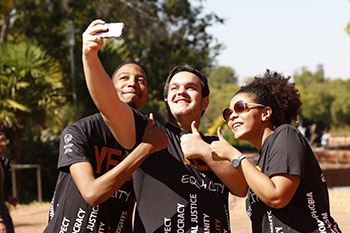
Photo: Johan Roux |
Photo Gallery
Speech by JC van der Merwe
On Monday 13 April 2015, the University of the Free State drew a line in history. Staff and students united in a singular vision: equality.
Since March 2015, the Institute for Reconciliation and Social Justice, together with the SRC, has launched the No-to-Racism/Yes-to-Equality Campaign across all three campuses with tremendous success. This campaign has now reached a high point at which the Kovsie community pledge their commitment to entrenching a culture of equality at the university. The first pledge ceremony took place on 13 April 2015 at the Bloemfontein Campus. Kovsies thronged to place their inked thumbprints on pledge posters in an inspirational show of solidarity.
“The key to transformation,” Prof Jonathan Jansen, Vice-Chancellor and Rector of the UFS, said, “is putting yourself in the shoes of the other person.” When you look past yourself and acknowledge others’ experiences, the world starts to look different. A pledge, Prof Jansen continued, is a solemn promise – not only to stop bad behaviour, but to go forward resolutely with good behaviour. “You do not change a campus, you do not change a country, without being courageous,” Prof Jansen said.
The message from Mosa Leteane, President of the Student Representative Council (SRC), echoed the same belief. “Today,” Leteane said, “the UFS takes a bold and courageous step toward equality.” This new generation, which includes young people from all races, has started a new revolution. A generation that says no to discrimination and yes to equality. “We cannot afford to be ignorant or indifferent,” Leteane urged.
The remaining two campuses will also have an opportunity to publically pledge their support on the following days:
Qwaqwa Campus: Wednesday 15 April 2015
South Campus: Friday 17 April 2015
To enable the university to go beyond dialogues and consultation towards active decision-making, a University Assembly will be held on Tuesday 28 April 2015. The assembly will serve as a space for critical engagement among all university stakeholders to focus on issues such as symbols, policies, practices, and curriculum. Staff and students are encouraged to submit matters for discussion to JC van der Merwe (vdmjc@ufs.ac.za) before 22 April 2015.
The No-to-Racism/Yes-to-Equality Campaign is aligned with the declaration made by the UFS Council in November 2014, in which it states that “the Council of the University of the Free State believes very strongly in the human dignity, equality, and freedom of all people.”